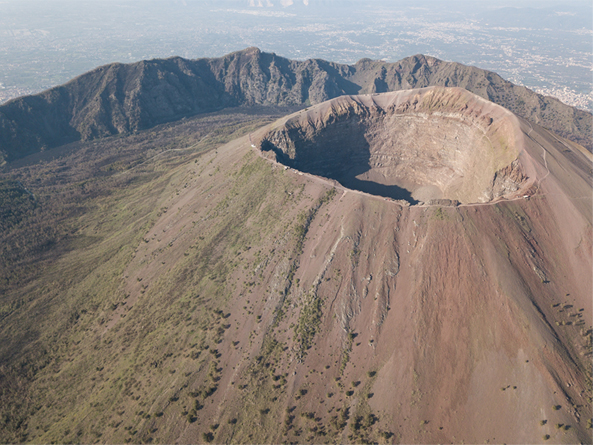
Mount Vesuvius is one of only a handful of active volcanoes in Europe. It is located on the west coast of Italy, overlooking the city of Naples. Vesuvius is responsible for some of Europe’s biggest volcanic eruptions, including the infamous eruption in 79 A.D. that destroyed the cities of Pompeii and Herculaneum. The last time Vesuvius erupted was in 1944, and it still presents a grave danger to the populated cities located around it.
The Vesuvius Problem
Mount Vesuvius is one of several volcanoes situated within the Campanian volcanic arc, which sits over a subduction zone that exists due to the connection of the African and Eurasian plates. The subduction zone runs along the entire length of Italy. Mount Vesuvius is located directly over a portion of the subducting slab that has separated from the main zone, forming a slab window. This separation has led to a differences in the rocks that erupt from Vesuvius compared to the rocks that erupt from the other volcanoes in the area. Most of the rocks coming from Vesuvius are andesite, which contains up to 63 percent silica. Andesite lava is known for its explosive eruptions, which mean that Mount Vesuvius is particularly unpredictable and dangerous. Although Vesuvius is currently only showing minor seismic activity and outgassing from the summit, an eruption could happen at any time.
- Mount Vesuvius, Italy
- Volcanoes: Nature’s Ticking Time Bombs
- Mount Vesuvius
- Tectonics and Geology of Mount Vesuvius
- Mount Vesuvius, Italy: Map, Facts, and Eruption Pictures
- Mount Vesuvius: Past and Present
- Profile of Vesuvius
Eruption History
Mount Vesuvius has had eight major eruptions over the past 17,000 years. The eruption that occurred in 79 A.D. is one of the most famous ancient eruptions, and it’s estimated that the eruption was responsible for the deaths of more than 16,000 people when debris rained down on Herculaneum and Pompeii to bury the cities.
Pliny the Younger was a Roman historian who witnessed and lived through the 79 A.D. eruption. He then wrote a detailed description of the cloud of ash and smoke that rose out of the volcano’s summit. From Pliny’s descriptions, volcanologists created the term “Plinian” to describe violent volcanic eruptions that involve large volumes of expansive gases, rocks, and ash. As the hot ash descended on Pompeii, it covered and suffocated victims. The people’s remains were preserved with many details readily discernible.
Between the 1600s and the early 1900s, Vesuvius was active, erupting ash, mud, and lava periodically. Some lava flows and gas explosions caused extensive damage and fatalities. The most recent eruption, in March of 1944, was significant because it occurred during World War II. The Italian government was in disarray as Allied forces pushed into the country, so the U.S. military took charge of evacuating residents and ensuring public safety. The volcano destroyed American materiel including dozens of B-25 bombers, but no military fatalities occurred as a result of this eruption. However, 26 Italian civilians lost their lives, and thousands lost their homes.
- March 17, 1944: The Most Recent Eruption of Mount Vesuvius
- Mount Vesuvius Boiled Victims’ Blood and Cause Their Skulls to Explode
- Mitigation of Volcanic Disasters in Densely Populated Areas
Future Eruptions
Although Vesuvius hasn’t erupted for more than 70 years, scientists say it’s only a matter of time before another major eruptions happens. Naples has a population of more than three million people, and the city is less than eight miles from the volcano. Currently, volcanologists monitor Vesuvius carefully, measuring seismic activity, magnetic field variations, ground deformation, soil and water temperatures, and the composition of gases from fumaroles. This careful monitoring should make it possible to give at least a two-week warning prior to the next eruption, which would be the amount of time needed to evacuate the people who live within the 15-kilometer red zone around Mount Vesuvius. A Vesuvius eruption would most certainly result in damage, but the extent of it would depend on the severity of the eruption. Experts say a 4 on the Volcanic Explosivity Index wouldn’t be out of the question, which could result in catastrophic loss of life and property damage, costing the Italians in excess of $20 billion. The Italian government has an emergency evacuation plan in place that should enable the evacuation of 600,000 people in 72 hours, and the government has also been working to create a buffer around the volcano, with fewer people living nearby.
- Forecasting Volcanic Eruptions
- The Volcanic Explosivity Index
- Prevention of Catastrophe in the Vesuvius Area
- Pompeii Plans for Evacuation in Case of Eruption
- Volcano Forecast? New Technique Could Better Predict Eruptions
- What if Mount Vesuvius Erupted Today?
- Predicting Eruptions
- Predicting Volcanic Eruptions: Modeling Magma Wagging to Anticipate Volcanic Behavior
- Volcanic Hazards and Prediction
This page was last updated by Marco Permunian
Additional Resources:
- Italian passport requirements
- Italian dual citizenship UK
- Italian citizenship jure sanguinis requirements
- IDC
- Italian dual citizenship Canada
- Dual Italian citizenship requirements
- Italian dual citizenship Australia
- How to get Italian dual citizenship
- Italian citizenship marriage
- Italian dual citizenship Brazil, Argentina and South America
- Benefits of Italian citizenship





